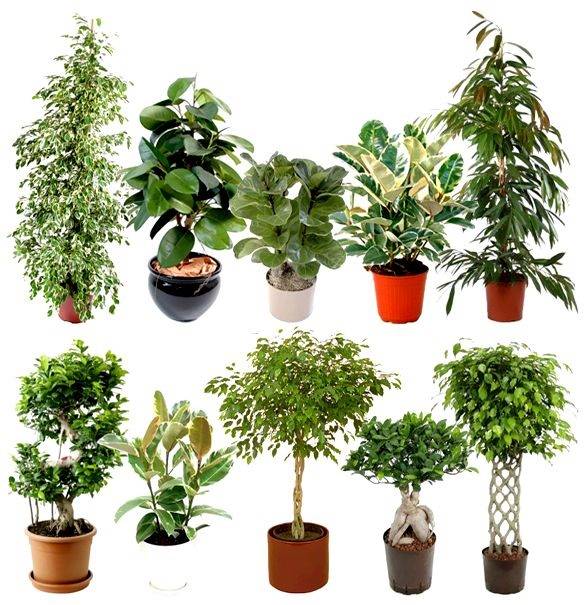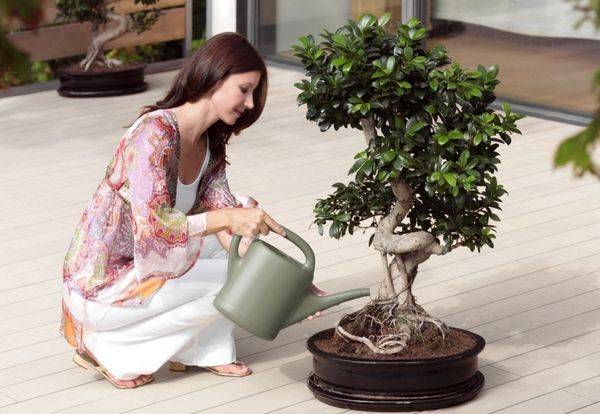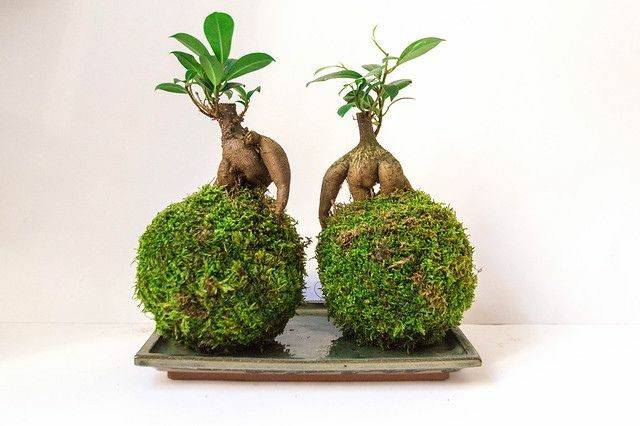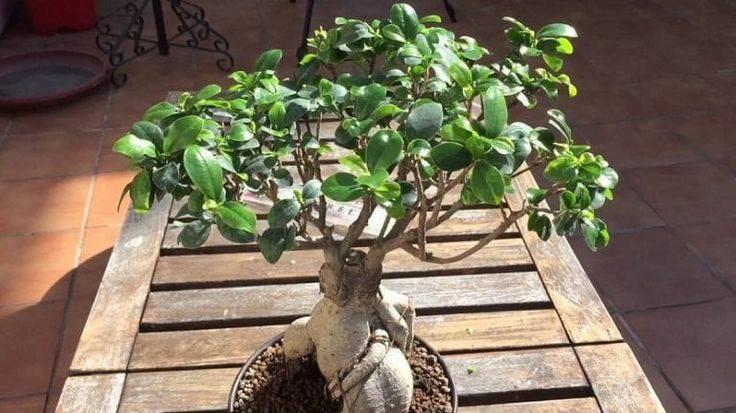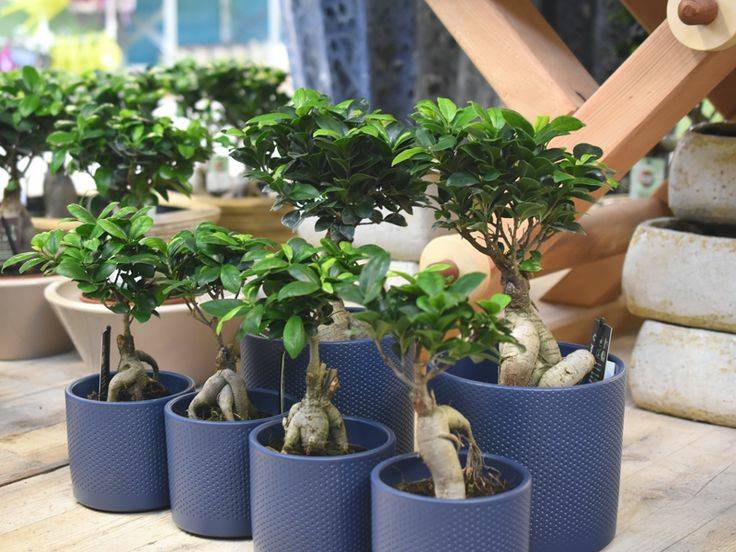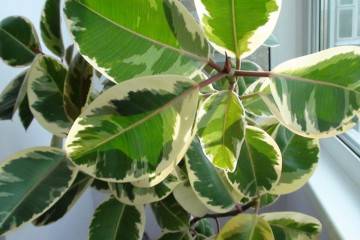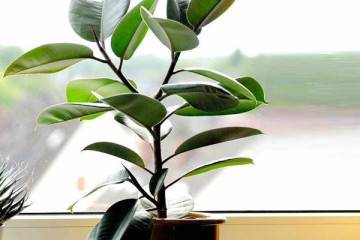Ficus Ginseng - home care
Content:
Many indoor plant lovers admire the view of ornamental bonsai trees. However, they are stopped from buying such a plant by the thought of complex care for it. Ficus microcarpa Ginseng is a representative of this kind of miniature trees with amazing aerial roots and a spreading crown. And most importantly, it is so resilient that it does not require undue attention, and it is easy to care for.
History of the appearance of ficus Ginseng
Ficus Ginseng from the microcarp series is a plant from the Mulberry family. The Latin versions of the name are Ficus microcarpa Ginseng, or Ficus Retusa. The word "ginseng" is translated from English as "ginseng", and the tree of the same name in Chinese means "root", which best describes the peculiarity of this type of ficus - its powerful root system, an impressive part of which is located above the soil surface. And this appearance is not given to the plant by nature, but is formed thanks to the efforts of breeders.
In nature, the ficus Ginseng grows in tropical and subtropical climatic zones, namely in Indonesia, Taiwan, Japan, the Philippines, Northern Australia, Southeast China. It is unpretentious to the environment, so plants can be found even in cracks in rocks, asphalt and on the roofs of houses.
The flower can grow up to 25 m in height. Its trunk with powerful hanging roots is framed by a crown of evergreen glossy leaves of a dark shade. Each leaf grows up to 15 cm in length.
Common varieties of ficuses
In indoor floriculture, you can find many varieties of ficuses, in addition to Ginseng. These include:
- rubber (Ficus Elastica);
- ficus lyre (Ficus Lyrata), among the varieties of which are Compact, Bambino and Phyllis Gred;
- ficus Benjamina (Ficus Benjamina), which includes varieties such as Daniel, Golden Monique, Exotic, Starlight, Naomi Gold, Kinky, Safari, Boucle, Viandi, Baroque;
- ficus Binnendiyka (Ficus Binnendiijkii), the varieties of which are Ali, Amstel King, Amstel Queen, Amstel Gold;
- dwarf ficus, or pumila (Ficus Pumila), its varieties are Sunny, White Sunny, Dort;
- ficus bengal (Ficus Benghalensis);
- mountain ficus (Ficus Montana);
- ficus carica (Ficus Carica);
- ficus pseudopalm (Ficus Pseudopalma);
- ficus ear (Ficus Auriculata);
- ficus palmeri (Ficus Palmeri);
- ficus goblet (Ficus Cyathistipula).
Microcarpa Ginseng is the only home-grown mulberry ficus that grows like a bonsai. The height of the plant does not exceed 50 cm, and most of it is a powerful rhizome, outwardly similar to the root of ginseng. However, the stem of the plant is not strong and easily damaged. From above, it is covered with a smooth and thin greenish skin. The leaves are small and resemble those of Benjamin's ficus, the ends of the leaf blade are more rounded and blunt.
Bonsai Ginseng blooms in small purple inflorescences, similar to berries. After they fall, real berries are formed. They are not poisonous, but they are not suitable for food because of their unpleasant taste.
Ficus microcarpa Ginseng: home care
It is easy to care for the Ginseng ficus, it is enough to follow the step-by-step instructions for all life-supporting cultivation measures.
Temperature
Ficus microcarp is a thermophilic plant. In the summer, the temperature regime should be between 18 ° С - 23 ° С. In winter, the room should be at least 16 ° C. The most unfavorable state of the environment is sudden temperature changes.
Lighting
The plant adapts well to both natural and artificial lighting. The best option is diffused light, but if this is not possible, then it is better to put the pot with the plant in partial shade than to leave it in direct sunlight, which can scorch the leaves of the Ginseng ficus.
Watering
Ficus Ginseng has large aerial roots and a powerful branched root system. In winter, he needs moderate watering no more than once a week to avoid root rot. Between procedures, the earthen ball should dry 3 cm from the surface, this depth is equal to the length of the phalanx of the thumb. An alternative option would be to wet the dense soil. To do this, a pot with a tree is placed in a deep basin with warm water for 6-8 hours.
Spraying
The homeland of ficus is the tropics, where the air is humid and frequent heavy rains. Therefore, the plant takes the main moisture for life during the spraying procedure. Spraying the foliage canopy will help recreate wildlife conditions. The procedure should be carried out 1-2 times daily. The main thing is not to get water on the aerial roots and trunk. In addition, it is worth carefully wiping the leaves with water, but only boiled water, this will help to avoid white stains on them.
Humidity
An important parameter is the humidity in the room. It should not be lower than 50%.
Priming
The Ginseng cultivar needs to grow in drained fertile soil, the acidity of which is pH 5.5-7.5. Such a primer can be purchased at a specialized store or made on your own. The soil is selected according to the age of the plant.
For a young plant, a loose and well-breathing soil is needed. It is mixed in the following proportions:
- leaf turf - 1 part;
- coarse sand - 1 part;
- peat - 1 part;
- wood ash or fine charcoal - ½ part.
The adult ficus Ginseng requires a denser soil, so that the rhizomes are closely intertwined inside the pot, and the aerial roots have a firmer foundation under them. For the soil mixture you will need:
- leaf land - 2 parts;
- coarse sand - 2 parts;
- turf - 2 parts;
- humus - 1 part;
- wood ash or fine charcoal - ½ part.
For this, leaf and turf soil are mixed in equal proportions, ½ of coarse sand is added to them. Charcoal and peat soil can be used as a supplement.
Top dressing
Top dressing is an important component of successful growth and possible flowering of ficus microcarp. During the period of active growth, which occurs in the summer-autumn period, it is necessary to fertilize the plant twice a month, alternating mineral and organic nutrients. In winter, this amount is reduced to one, feeding is carried out during watering. Also, the plant responds positively to the foliar fertilization method - directly to the deciduous crown.
Features of winter care
The care of any plant varies with the season. And ficus Ginseng is no exception in this matter. From November to February, the plant begins a dormant period. Several rules of care to comply with during this period:
- in winter, due to heating, air humidity decreases to 30-40%. It is important to maintain the required 50-60% by spraying;
- dressing is enough 1 time in 30-40 days;
- flower growers recommend a warm shower once every 2-3 weeks for additional moisture if the air in the apartment is excessively dry and hot;
- if the plant is in a shady cool environment, the need for water is reduced;
- the pot with the plant should be rearranged as far away from the heaters as possible, while maintaining adequate lighting for growth.
Pruning
So that the ficus Ginseng does not lose the aesthetic appearance of the bonsai, you need to prune the crown every 3-4 years. If this is not done, the branches stretch upward. Ficus branches are very plastic, and the plant easily tolerates the procedure of crown shortening. For ease of crown formation, you can focus on the direction of growth of the largest branch. You need to cut off up to 2-4 leaves, so that later the bonsai has a spreading and branched crown. In addition, damaged and dried microcarp shoots must be removed in a timely manner.
How ficus Ginseng reproduces
Ficus Ginseng is one of the most unpretentious species. Therefore, the ease of growing a purchased specimen makes you want to grow a new plant of this species on your own. However, before you try, it is important to know that the root system of a newly planted microcarp will not resemble the root system of the ficus parent.
There are four breeding methods.
Propagation by cuttings
In early spring, a lignified shoot up to 15 cm in length is cut from an adult plant, leaving three pairs of leaves. After that, the stem is placed in a glass of water for two hours to wash off the milky juice. Next, you need to let the cutting dry. The stalk, the cut of which is pretreated with a solution of root or heteroauxin, is planted in peat-sandy soil in a 1: 1 ratio with the addition of vermiculite and covered with polyethylene or a glass flask. The greenhouse is placed in a bright and warm room, the care of the planted cuttings is limited to rare airing and watering once a week. It will be possible to plant a stalk in a pot after 2-3 months, after its rhizome gets stronger.
Root cuttings
The method is similar to propagation by cuttings, only a part is cut off from an adult plant. It is also placed in water for several hours, and then immediately planted in a substrate of peat and sand so that the top of the root peeks out of the ground by 2-3 cm. Greenhouse conditions are created again with the help of polyethylene. Care consists of one-time watering per week and airing the plant.
Propagation by air layers
With this method, the bark of 2-3 cm wide is cut off the trunk in a circle. Bare wood is covered with wet sphagnum, and polyethylene or cling film is placed on top of the moss. It is important that the moss is always moist. Over time, new cuttings will grow at the cut sites, which can be cut and transplanted into the soil prepared for the new plant.
Seed propagation
The seed is covered with peat mixed with sphagnum, covered with foil and watered once a week until sprouts appear. This method is less commonly used, as it is easier to grow bonsai with a vegetative method than with seed propagation. It is highly likely that an ordinary ficus will grow in a pot with self-seed planting.
Transfer
Ficus Ginseng is considered a young plant up to 5 years of age, therefore, during this time, it must be replanted every year with a complete replacement of the soil. An adult plant needs a new pot every 2-3 years, in which a new substrate is added to the old soil. Expanded clay is poured into the bottom of the pot in an even layer, and the top of the soil is sprinkled with sand.
Homemade soil options for transplanting microcarp:
- leaf land, peat land, turf land and sand in equal proportions;
- sand, clay granulate and picking earth in equal amounts;
- sod land, peat land, sand with the addition of charcoal in a ratio of 2: 1: 1.
Possible growing problems and diseases
Despite the fact that the ficus Ginseng does not require painstaking care, when the environment changes or pests appear, the plant can get sick. There are several symptoms of microcarp disease.
Drops the leaves
If the crown of the ficus began to thin out, then the cause of shedding of green foliage can be:
- temperature drops, draft;
- rearrangement of a pot with a plant in radically different conditions (plant adaptation);
- decay of the rhizome from excessive watering.
Leaves turn pale or change color
Loss of bright green color in leaves is usually due to:
- stagnant water in the pan, which can lead to rotting of the leaves, which will cause them to turn black;
- lack of minerals in the feed, due to which the crown may lose its bright green color.
Leaves dry
When the leaves turn yellow and dry to the touch, care should be taken to include:
- lighting and air humidity, especially in winter;
- watering and spraying;
- top dressing with the addition of minerals.
Pests
Not a single grower is immune from pest attacks on indoor plants. Among the dangerous for ficus Ginseng are:
- spider mite;
- aphids;
- mealybug;
- thrips;
- scabbard.
If the problem is pests, the plant should be treated with insecticides such as actellic. After chemical intervention, the ficus will quickly recover and regain its previous healthy appearance.
Signs and superstitions
Ficus in the house is beneficial. Like any leafy plant, it purifies indoor air, but it also fights harmful chemicals such as formaldehyde and benzene. The advantage over other plants is the ability to filter air from bacteria and destroy up to 40% of them.
However, there are a number of signs and superstitions regarding whether it is beneficial to grow ficus, including ficus ginseng, at home.
- Ficus loves moderate watering.Because of this feature of the plant, there is a sign that vulnerable and sensitive people must definitely take it into their homes. This will help them avoid excessive tears and become less susceptible to hurt feelings.
- According to Ayurveda, traditional medicine in India with a long history, ficus normalizes energy balance, reducing anxiety and getting rid of internal disharmony.
- Ficus is considered a fertility tree. If a woman wants to get pregnant as soon as possible, then you should put the pot with the plant in the bedroom and, while caring for it, show heartfelt care, as if she were caring for a child. This ritual will produce hormones that help to establish a hormonal balance favorable for conception.
- According to the Taoist feng shui practice, it is recommended to put a ficus tree in the corner of the living room to create a friendly atmosphere, which will help to gather many guests in the house for a pleasant pastime. However, there are places in the apartment where the ficus should not be placed, otherwise its energy will negatively affect the people living in it. This is the northeastern and southwestern parts of the apartments, as well as the center of the rooms.
Ficus Ginseng (microcarpa) is one of the most popular representatives of the Mulberry family due to its resemblance to the bonsai tree. Contrary to thoughts about laborious care, the ficus Ginseng will feel good with moderate watering, under the scattered rays of the sun and with sufficient heat and humidity (the standard temperature in apartments is just 20-23 ° C). If desired, cuttings can be obtained from an adult plant for subsequent planting and increasing the number of miniature trees in the house. Infrequent feeding with the addition of minerals and organics will protect the plant from the threat of disease, and in the case of forced treatment from pests, microcarp will quickly recover. Ficus is an evergreen plant, it helps to maintain the cleanliness and freshness of the air in the room, and according to numerous beliefs, it is recognized as a favorable example of the world of flora for creating a sense of harmony and comfort in an apartment.

